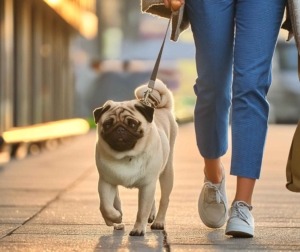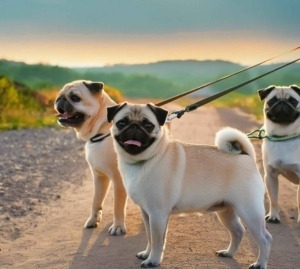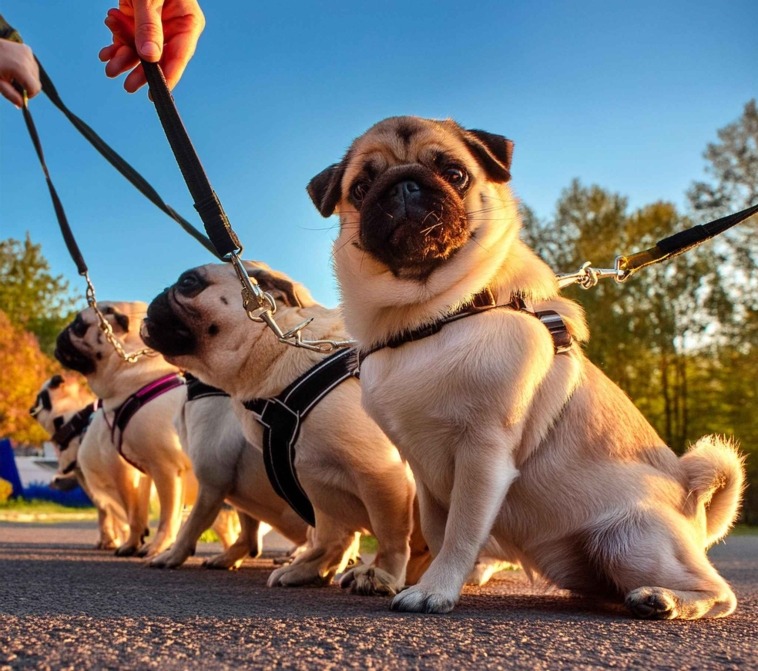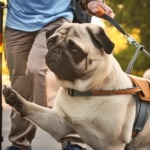Last updated on October 5th, 2024
Here’s an overview:
Introduction to Pug Leash Manners
Understanding Pug Behavior on a Leash
Choosing the Right Leash and Harness for Your Pug
Starting with Basic Training Commands
Consistency and Patience in Training
Positive Reinforcement Techniques
Dealing With Common Leash Problems
Incorporating Socialization into Leash Training
Safety Tips for Walking Your Pug
Addressing Leash Training Setbacks
Pug-Specific Considerations and Tips
Preparing for Different Walking Environments
Conclusion and Encouragement for Pug Owners
Introduction to Pug Leash Manners
Pugs are different in their body structure, which is unique among dog breeds, and they have a personality that loves to play; therefore, Pug leash manners training to them is not ordinary. Being brachycephalic, its breathing and joint health should come first. To leash train a pug involves making sure it does not pull or choke.
Key Considerations:
- Right Gear: Harness instead of collar in order to reduce pressure on the neck.
- Temperament Handling: Recognize their sensitivity; apply positive reinforcement.
- Use Consistent Cues: Consistency in commands will avoid confusion.
- Keep Sessions Short: Train regularly but briefly since their attention span is short.
- Ensure Sociability: Build confidence by exposing them to various environments.
Understanding Pug Behavior on a Leash
A pug breed of dogs are known for being adorable and highly sociable with others yet can show different behaviors while on a pug leash manners. Walking difficulties resulting from the brachycephalic (short-nosed) feature if affected might lead to problems during walks.

- Tendency of Pulling: Often pulling due to excitement or curiosity.
- Breathing Issues: Ensure harnesses do not restrict airflow.
- Stubbornness: If there’s no motivation then they may resist your commands here and there.
- Sociable Interaction: They seem ever friendly wanting to meet everyone around them and say hi!
- Easily Distracted: They will easily get distracted by anything when walking..
These behaviors are crucial for effective leash training as well as safety and well-being of the pug.
Choosing the Right Leash and Harness for Your Pug
The selection of the right gear for comfortable walking is important. Some basic tips include:
- Type of Harness: Soft padded harness will prevent strain on delicate necks and tracheas of Pugs,
- Leash material: Nylon or leather leashes tend to last long hence advisable,
- Leash Length: A leash between 4 and 6 feet provides both freedom and control.
- Adjustability: It is important to ensure that the harness fits snugly on the dog’s body without restricting movements.
- Safety Features: Visibility should be enhanced such as through reflectivity in low light conditions.
Through correct equipment they can be trained better on leashes, which in turn will make them more comfortable and safer.
Starting with Basic Training Commands
The basic commands are meant to ensure that the walk is enjoyable, but also disciplined. Some of these critical commands are:
- Sit: It helps calm pugs before you start strolling.
- Stay: This helps a dog keep still when required.
- Heel: The dog should learn to move closely with its owner’s side.
Consistency in applying these set of instructions include;
- Use treats for positive reinforcement,
- Keep your tone firm and clear,
- Start practicing initially in a non-distracting environment,
Successive practice creates a solid base for advanced pug leash manners for safer walks full of pleasure.
Consistency and Patience in Training
It is important to have a consistent approach during leash training. This means that owners must:
- Establish a Routine: Daily walks should be done at the same time always.
- Use Clear Commands: Use simple, constant orders such as “heel” or “stop.”
- Offer Reinforcement: Treats or verbal praise immediately after positive behavior.
- Assess Progress Regularly: Check improvements frequently and adjust tactics accordingly.
Pug training requires patience. In this case, owners should:
- Avoid Frustration: Keep yourself composed whenever there are some setbacks so as not to stress out both the dog and yourself if possible,
- Practice Repetition: Better retention through repetition reinforcement of lessons
- Build Duration Gradually: Gradually increase the duration of each walk until stamina builds up
Positive Reinforcement Techniques
Through rewards, positive reinforcement ensures that dogs know what is needed from them regarding proper pug leash manners while walking on leashes.
Key Techniques
- Treats: Choose healthy, small treats. Give treats for every successful leash training execution.
- Praise: As soon as they have done it correctly, use an enthusiastic voice to praise them.
- Clicker Training: Make sure to click the moment your pug does something right and follow it up with a treat.
- Consistency: Have all members of the family using the same commands and reward system.
- Timing: To enable the dog learn, give rewards as soon as possible after he has done what was asked of him.
Doing this every time will help create a positive learning environment.
Dealing With Common Leash Problems
Tugging on the Leash
- When your pug pulls, stop immediately as this encourages positive behavior in it.
- The leash should only be pulled when it becomes slack.
- By acting consistently reinforcement works best.
Leash Reactivity
- Where feasible identify triggers and avoid them at all costs.
- Utilize counter-conditioning methods to make these triggers enjoyable for your pet again.
- Take professional advice where need be.
Refusal to Walk
- Check whether or not you have correctly fitted and comfortably designed harnesses for necks to be more comfortable than before in those walks made by dogs on leashes around neighborhoods.
- Move forward with treats being used as an incentive for walking slowly.
- Make sure you increase walk lengthening and timing gradually.
Chewing on the Leash
- Distract the dog with a toy or treat. redirect its attention.
- Use pet safe bitter sprays that deter chewing.
- Apply a pet-safe bitter spray to deter chewing on the leash by dogs during training sessions held outside homes.
Advanced Leash Training Tips
- Consistency is Key: Always have a schedule. Keep using the same command words plus gestures.
- Positive Reinforcement: Provide praise plus treat right after they have done what was expected.
- Gradual Challenges: Gradually make it harder by introducing different types of distractions into training areas that start off with silence and then become noisy.
- Proper Equipment: Buy strong leashes and good fitting harnesses to control them comfortably.
- Calm Departure: Ensure the pug is calm before you leave the house, reward calmness.\
- Directional Training: Train pugs to know their lefts and rights so that they can be directed when necessary.
- Controlled Socialization: Let it happen but stop pulling or getting over-excited.
Incorporating Socialization into Leash Training
Introducing socialization into leash manners training improves confidence and behavior of pugs.
Walks in Varied Environments:
- Parksstrolls
- urban parksbusy
- streetsquiet neighborhoods
Controlled Interactions:
- Other dogs
- friendly strangers
Exposure to Different Sounds and Sights:
- Traffic noises
- other pets
- different surfaces (grass, pavement)
Positive Reinforcement:
- Treats for calm behavior
- verbal praises
The socialization sessions should start off in brief periods and then gradually lengthen as the pug gets more familiar with it but shortness is key.
“Proper socialization minimizes anxiety, ensuring a well-rounded, leash-trained pug.”
Safety Tips for Walking Your Pug
- Use a Harness: To prevent the risk of neck injury and strain, use a harness instead of collar.
- Choose the Right Leash: Opt for a sturdy, non-retractable leash to maintain control and prevent accidents.
- Avoid Extreme Temperatures: Pugs can overheat easily. Walk during cooler times of the day and watch for signs of overheating.
- Stay Hydrated: Take water with you if you are going on long walks or it is hot out.
- Be Aware of Surroundings: Watch out for other dogs too aggressive drivers bad objects like toys around your pet.
Addressing Leash Training Setbacks
When leash manners training goes wrong, it can be very annoying, but it is important to understand and deal with these problems in order to succeed.

Pulling on Leash:
- As soon as the pug pulls, stop walking.
- After the leash has become loose, continue walking once more.
- Reward good behavior.
Fear or Anxiety:
- Let the pug know what the leash is by using it indoors.
- Start with outdoor environments gradually.
- Use positive reinforcement.
Distractions:
- Begin training in areas with less things that draw attention for now .
- Increase distractions slowly.
- To maintain focus use high-value treats.
Inconsistency:
- All handlers should be able to say same commands/techniques and engage in same actions towards your dog
- Keep a steady routine of consistent practice every day without break
- These challenges will go away with time if you do regular and consistent training while being patient enough.
Pug-Specific Considerations and Tips
Physical traits and personality make pugs different from other breeds. Important factors include;
- Harness vs. Collar: Use a harness to prevent putting pressure on the delicate necks and respiratory system of pugs.
- Short Snout Sensitivity: They are brachycephalic so don’t overdo activities in which they participate or expose them to heat.
- Stubbornness: Pugs have strong minds that are difficult to bend. Train all the time consistently with patience being your virtue as well as theirs!.
- Short Attention Span: Train through short sessions only when they can still pay attention fully when learning new tricks.
- Socialization: It is important for owners to regularly socialize their Pugs so that they can overcome this problem of not getting along with other dogs. Positive Reinforcement: This method appeals to millions of dog owners because they prefer keeping their pets healthy at all times by giving them food or toys whenever necessary
Preparing for Different Walking Environments
Walking environments may differ greatly thus affecting both parties; pet owner/pug itself. However, each environment needs its own approach and preparedness.
Urban Areas:
- Make sure there is secure leash and harness in place.
- Watch for traffic and stay away from crowded streets.
- Take with you several waste bags to facilitate cleaning up of the dog’s droppings.
Parks and Trails:
- Longer leashes will allow more exploration.
- Look out for wildlife signs
- Carry water to keep hydrated during the walk
Beach and Coastal Areas:
- Waterproof leash will be useful in such cases
- Keep an eye on tidal changes
- You may need to protect your pug’s paw if the sand is too hot.
Conclusion and Encouragement for Pug Owners
For both the Pug owner and his pet it is necessary that they master the use of a leash. The practice should not be abandoned as regular training helps build confidence, thus bringing owners closer to their dogs. We must also remember that positive reinforcement works best when used by dog trainers who want their dogs always behave properly on a leash. Walking your well-behaved pug on a leash must become pleasant walks which ensure safety for everyone around it.
Key Points to Remember:
- Patience: Each dog learns at its own pace; therefore, training takes time.
- Consistency: Regular practice helps reinforce good behavior patterns while routines act as reminders so that pooches do not dwell on bad habits again!
- Positive Reinforcement: However, it is better to use treats instead of using force as a way of making your pets follow certain orders or perform specific actions like duels.
By following these guidelines, owners can enjoy pleasant walks with their well-mannered Pug.
Content from: Abdullah (Senior Trainor)




